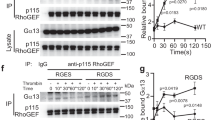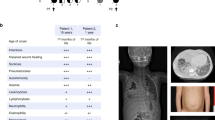Abstract
Monogenic deficiency diseases provide unique opportunities to define the contributions of individual molecules to human physiology and to identify pathologies arising from their dysfunction. Here we describe a deficiency disease in two human siblings that presented with severe bleeding, frequent infections and osteopetrosis at an early age. These symptoms are consistent with but more severe than those reported for people with leukocyte adhesion deficiency III (LAD-III). Mechanistically, these symptoms arose from an inability to activate the integrins expressed on hematopoietic cells, including platelets and leukocytes. Immortalized lymphocyte cell lines isolated from the two individuals showed integrin activation defects. Several proteins previously implicated in integrin activation, including Ras-associated protein-1 (RAP1)1 and calcium and diacylglycerol-regulated guanine nucleotide exchange factor-1 (CALDAG-GEF1)2, were present and functional in these cell lines. The genetic basis for this disease was traced to a point mutation in the coding region of the KINDLIN3 (official gene symbol FERMT3) gene3. When wild-type KINDLIN-3 was expressed in the immortalized lymphocytes, their integrins became responsive to activation signals. These results identify a genetic disease that severely compromises the health of the affected individuals and establish an essential role of KINDLIN-3 in integrin activation in humans. Furthermore, allogeneic bone marrow transplantation was shown to alleviate the symptoms of the disease.
This is a preview of subscription content, access via your institution
Access options
Subscribe to this journal
Receive 12 print issues and online access
$209.00 per year
only $17.42 per issue
Buy this article
- Purchase on Springer Link
- Instant access to full article PDF
Prices may be subject to local taxes which are calculated during checkout




Similar content being viewed by others
References
Hattori, M. & Minato, N. Rap1 GTPase: functions, regulation, and malignancy. J. Biochem. 134, 479–484 (2003).
Crittenden, J.R. et al. CalDAG-GEFI integrates signaling for platelet aggregation and thrombus formation. Nat. Med. 10, 982–986 (2004).
Ussar, S., Wang, H.V., Linder, S., Fassler, R. & Moser, M. The Kindlins: subcellular localization and expression during murine development. Exp. Cell Res. 312, 3142–3151 (2006).
Rogalski, T.M., Mullen, G.P., Gilbert, M.M., Williams, B.D. & Moerman, D.G. The UNC-112 gene in Caenorhabditis elegans encodes a novel component of cell-matrix adhesion structures required for integrin localization in the muscle cell membrane. J. Cell Biol. 150, 253–264 (2000).
Shi, X. et al. The MIG-2/integrin interaction strengthens cell-matrix adhesion and modulates cell motility. J. Biol. Chem. 282, 20455–20466 (2007).
Siegel, D.H. et al. Loss of kindlin-1, a human homolog of the Caenorhabditis elegans actin-extracellular-matrix linker protein UNC-112, causes Kindler syndrome. Am. J. Hum. Genet. 73, 174–187 (2003).
Dowling, J.J. et al. Kindlin-2 is an essential component of intercalated discs and is required for vertebrate cardiac structure and function. Circ. Res. 102, 423–431 (2008).
Kruger, M. et al. SILAC mouse for quantitative proteomics uncovers kindlin-3 as an essential factor for red blood cell function. Cell 134, 353–364 (2008).
Moser, M., Nieswandt, B., Ussar, S., Pozgajova, M. & Fassler, R. Kindlin-3 is essential for integrin activation and platelet aggregation. Nat. Med. 14, 325–330 (2008).
Dowling, J.J., Vreede, A.P., Kim, S., Golden, J. & Feldman, E.L. Kindlin-2 is required for myocyte elongation and is essential for myogenesis. BMC Cell Biol. 9, 36 (2008).
Ma, Y.Q., Qin, J., Wu, C. & Plow, E.F. Kindlin-2 (Mig-2): a co-activator of beta3 integrins. J. Cell Biol. 181, 439–446 (2008).
Alon, R. et al. A novel genetic leukocyte adhesion deficiency in subsecond triggering of integrin avidity by endothelial chemokines results in impaired leukocyte arrest on vascular endothelium under shear flow. Blood 101, 4437–4445 (2003).
Kuijpers, T.W. et al. Natural history and early diagnosis of LAD-1/variant syndrome. Blood 109, 3529–3537 (2007).
Quinn, M.J., Byzova, T.V., Qin, J., Topol, E.J. & Plow, E.F. Integrin αIIbβ3 and its antagonism. Arterioscler. Thromb. Vasc. Biol. 23, 945–952 (2003).
Newman, P.J., Seligsohn, U., Lyman, S. & Coller, B.S. The molecular genetic basis of Glanzmann thrombasthenia in the Iraqi-Jewish and Arab populations in Israel. Proc. Natl. Acad. Sci. USA 88, 3160–3164 (1991).
Shattil, S.J., Hoxie, J.A., Cunningham, M. & Brass, L.F. Changes in the platelet membrane glycoprotein IIb.IIIa complex during platelet activation. J. Biol. Chem. 260, 11107–11114 (1985).
Feng, X. et al. A Glanzmann's mutation in β3 integrin specifically impairs osteoclast function. J. Clin. Invest. 107, 1137–1144 (2001).
Kasirer-Friede, A., Kahn, M.L. & Shattil, S.J. Platelet integrins and immunoreceptors. Immunol. Rev. 218, 247–264 (2007).
Ginsberg, M.H., Partridge, A. & Shattil, S.J. Integrin regulation. Curr. Opin. Cell Biol. 17, 509–516 (2005).
Moyle, M. et al. A hookworm glycoprotein that inhibits neutrophil function is a ligand of the integrin CD11b/CD18. J. Biol. Chem. 269, 10008–10015 (1994).
Miura, Y. et al. Defective osteogenesis of the stromal stem cells predisposes CD18-null mice to osteoporosis. Proc. Natl. Acad. Sci. USA 102, 14022–14027 (2005).
Kinashi, T. Intracellular signalling controlling integrin activation in lymphocytes. Nat. Rev. Immunol. 5, 546–559 (2005).
Kinashi, T. et al. LAD-III, a leukocyte adhesion deficiency syndrome associated with defective Rap1 activation and impaired stabilization of integrin bonds. Blood 103, 1033–1036 (2004).
Alon, R. & Etzioni, A. LAD-III a novel group of leukocyte integrin activation deficiencies. Trends Immunol. 24, 561–566 (2003).
Mory, A. et al. Kindlin-3: a new gene involved in the pathogenesis of LAD-III. Blood 112, 2591 (2008).
Moser, M. et al. Kindlin-3 is for required for β2 integrin–mediated leukocyte adhesion to endothelial cells. Nat. Med. advance online publication doi:10.1038/nm.1921 (22 February 2009).
Larjava, H., Plow, E.F. & Wu, C. Kindlins: essential regulators of integrin signalling and cell-matrix adhesion. EMBO Rep. 9, 1203–1208 (2008).
Acknowledgements
We thank Roswell Park Cancer Institute Proteomics Resources, Lerner Research Institute Proteomics and Imaging Cores (J. Drazba) and Stranad Fellows I. Byzov and R. Swaninger for help with the project, A.Graybiel (Massachusetts Institute of Technology) for providing antibodies to CALDAG-GEF1 and L. Parise (University of North Carolina) for providing the GST-RALGDS fusion cDNA construct. This study was supported by HL073311 and HL071625 US National Institutes of Health grants.
Author information
Authors and Affiliations
Contributions
N.L.M. identified the Kindlin-3 mutation, performed molecular biology and protein biochemistry studies and wrote the manuscript; L.Z. contributed to study design and experiments on primary leukocytes from subjects; J.C. performed assays with EGFP-Kindlin-3 rescue and siRNA-mediated KINDLIN3 knockdown and western blotting; A.C. performed microscopy studies and FACS analysis; O.R. performed cell culture work and molecular biology; Y.-Q.M. performed molecular biology and Kindlin-3–specific antibody preparation; E.A.P. performed platelet studies; M.T. performed neutrophil analysis; D.P.L. and A.I.C. performed osteogenesis assays; S.B.S. originally described the subjects, designed clinical studies and wrote the manuscript; E.F.P. designed the studies, interpreted the results and wrote the manuscript; T.V.B. performed experiments with platelets and leukocytes, designed the general strategy, interpreted data and wrote the manuscript.
Corresponding author
Supplementary information
Supplementary Text and Figures
Supplementary Methods, Supplementary Figs. 1–6 and Supplementary Note (PDF 1270 kb)
Supplementary Movie 1
Movie 1 of subject's cells transfected with control GFP vector. Differential Interference contrast (DIC) and fluorescence are shown. Frames were recorded every 5 seconds. Subject's cells float but fail to adhere to fibronectin. (AVI 1015 kb)
Supplementary Movie 2
Movie 2 of subject's cells transfected with kindling-3-GFP fusion construct. Differential Interference contrast (DIC) and fluorescence are shown. Frames were recorded every 5 seconds. Upon expression of KINDLIN-3, subjects cells attach and spread on fibronectin. Note raffles formation and active movement of KINDLIN-3 overexpressing cells. Movies of representative cells are shown. (AVI 1099 kb)
Rights and permissions
About this article
Cite this article
Malinin, N., Zhang, L., Choi, J. et al. A point mutation in KINDLIN3 ablates activation of three integrin subfamilies in humans. Nat Med 15, 313–318 (2009). https://doi.org/10.1038/nm.1917
Received:
Accepted:
Published:
Issue Date:
DOI: https://doi.org/10.1038/nm.1917
This article is cited by
-
Structure, signal transduction, activation, and inhibition of integrin αIIbβ3
Thrombosis Journal (2023)
-
Clinical and Osteopetrosis-Like Radiological Findings in Patients with Leukocyte Adhesion Deficiency Type III
Journal of Clinical Immunology (2023)
-
Kindlin-2 preserves integrity of the articular cartilage to protect against osteoarthritis
Nature Aging (2022)
-
Kindlin3 regulates biophysical properties and mechanics of membrane to cortex attachment
Cellular and Molecular Life Sciences (2021)
-
Mesenchymal stem cell treatment improves outcome of COVID-19 patients via multiple immunomodulatory mechanisms
Cell Research (2021)



